Sony A75L
Product Name: Sony A75L
Product Description: 2023 4K OLED TV
-
Build Quality - 8.8/10
8.8/10
-
Image & Audio - 9/10
9/10
-
Connectivity - 9/10
9/10
-
OS & Smart Features - 9.3/10
9.3/10
-
Price / Quality - 9.2/10
9.2/10
Summary
Reviewed at $1,199.00 (55″)
Pros
- Deep blacks with no blooming
- Great colors
- Many online and smart features
- Most affordable OLED TV
Cons
- Not the most bright of TVs
- Only 2 HDMI 2.1 ports
- No FreeSync, 1440p or 144Hz support
- One stand position only
Cheapest Places to Buy :
*We are a reader-supported website. When you buy through links on our site, we may earn a small affiliate commission at no extra cost to you. Home Media Entertainment does not accept money for reviews.*
Introduction
OLED TVs are a fan favorite for many years now. They may have their own fair share of problems. But most people agree that if you want some of the best quality out there, OLED is the way to go. And now there are far more low cost options to choose from. And so in our Sony A75L review we will test this new affordable OLED TV that was recently released.

In 2022 Sony decided to introduce a new model in their OLED series that would be their most affordable yet, the A75K. So it was a bit surprising to see a replacement model missing from their new product lineup early this year. But it seems that Sony kept this one for a later time. As they announced its replacement in the 2nd half of 2023 and is available now. Keep in mind that the A75L is available in the US market but not in Europe. The reasons for this are unknown.
So let’s go over the specs real quick. The TV uses a 120Hz WOLED panel, comes with Cognitive Processor XR and Sony’s Acoustic Surface Audio system. There is Dolby Atmos, DTS and Dolby Vision support. We also find two HDMI 2.1 ports with VRR out of the box, and obviously uses the Google TV platform. There is a plethora of extras including Chromecast, Airplay 2, Homekit, Bravia Core, voice control, Netflix calibrated mode, IMAX Enhanced, Calman Ready and Bravia Cam support.
Upon first look the A75L looks awfully similar to the A80L. The only notable difference seems to be the downgraded audio system. But for almost $300 less are there any other specs that were downgraded to achieve this price? Let’s dig deeper to find out.
Design
As always we start with the design. And after careful inspection it seems that the A75L is indeed almost entirely the same as the A80L.
The TV has the exact same curvy back side as the A80L and all elements seems to be the same. Plastic is the main material used but overall construction is very sturdy and up to Sony’s standards.
Measurements
Thickness was measured at about 2.1″ (5.3 cm) which is exactly the same as the A80L. The TV is so thin due to the use of an OLED panel. But as usual the lower part is always thicker due to the inclusion of all electronics and audio system.
Its borders were measured 0.3″ (0.8mm) making the screen look really nice and immersive.
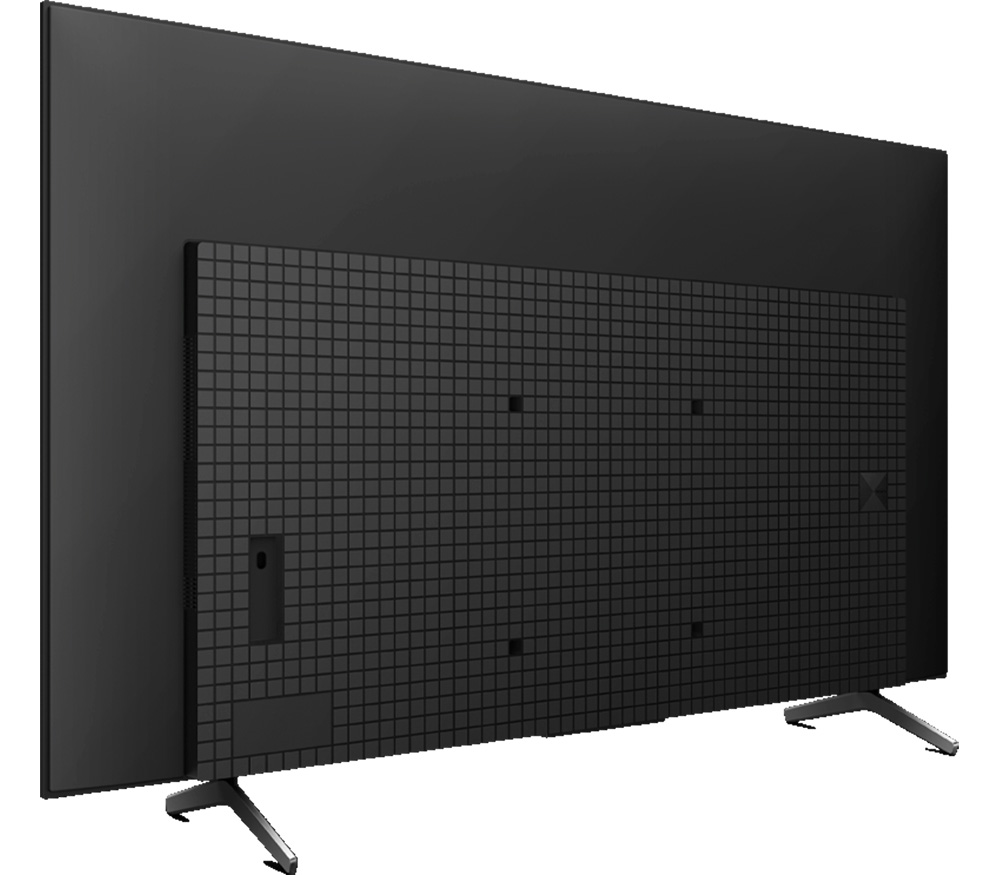
Back Side
The back of the TV is using the same grid style design that we saw in the A80L. The ports are again all on the right side looking sideways for easy access if you want to place it on a wall.
The power connector is on the left side. While the VESA mounting holes are the only other element visible. The XR logo that was visible in the middle of some 2021 TVs and was gone last year is still missing.
As far as cable management, everything remains the same. No grooves to drive the cables through and no special clips that could attach to the legs and keep all cables together.

Stand
The first obvious difference we see in the A75L is the different stand design. The one that comes with this unit is the usual bench type one which usually needs a large surface to place the TV on.
The difference is its looks, quality and practicality. It terms of looks the A75L uses V-shaped legs instead of straight ones. These are made of plastic and are not from metal as its more premium brothers. And lastly with this TV you have only one placement option. You don’t get the multi-position stand of other Sony TVs. So not many options here.
At least the stand leaves enough space between the surface and the panel in order to place a soundbar underneath.
Remote
As for the remote, this is exactly the same one we saw in some of the other 2023 Sony TVs, like the A95L and the X93L.
Sony really found a nice balance for their buttons layout. It is not as cluttered with buttons as LG’s remotes are and is a bit more functional than Samsung’s One Remote. The number of buttons is just the right one and you will never feel troubled pressing the correct one.

The remote obviously comes with a built-in microphone for issuing your commands to the TV and also comes with six dedicated buttons instead of four available last year.
In the 2023 version you will find buttons for the usual Netflix, Amazon Prime, Disney Plus and Youtube. Sony also added their own Bravia Core Service and Chruncyroll. It appears that Crunchyroll is an online service for anime and manga so it makes sense to see this from Sony. But we really doubt how many will be using this except from very specific markets.
Video Quality
Processor technology used
In terms of image processing the A75L uses Sony’s best Cognitive Processor XR which is the same chip used across most premium and top tier TVs from Sony.
The Cognitive Processor XR divides the screen into hundreds of zones and recognizes individual objects in these zones better than ever before. What’s more, it can cross-analyze around a few hundred thousand different elements that make up a picture in a second like focal points, contrast, colors, motion and clarity and determine ways in order to improve the end result even more.
Just from the naming you may think that the A75L is using the exact same chip as many Sony TVs did the previous years. In reality Sony made certain improvements in their processor this year, even though it uses the exact same name.

The new addition is called “XR Clear Image”. This new feature gets the input signal and cleans it up with its Signal Characteristics Analysis. This is checking resolution, encoding parameters and bitrate among others in order to apply its Adaptive Noise Resolution and Adaptive Super Resolution.
To make it simple to understand, this technology works with low quality streaming and broadcasting content in order to clean the image as much as possible. It can work in parallel with the TV’s upscaling features in order to give you an image that is up to 4K resolution standards. Although do not expect this to perfectly work across all content. But in certain cases the results can be rather impressive.
Resolution and Up-scaling
As always first comes our upscaling testing. We run a few videos in different resolutions ranging from ultra low quality ones, some 480p DVDs, some in 720p and obviously 1080p resolutions. We tried broadcasting signals, streaming content and discs to have a better, all around idea of the TV’s capabilities.
The A75L proved to be as capable as most other top Sony offerings this year, including the A80L. Low quality content looked very good. There was only minor loss of detail while macro-blocking was kept to a minimum in the content we tried.
With lower resolution videos the A75L’s upscaling capabilities were amazing. The TV applied the right amount of sharpness, without going overboard. Most details of the original content were preserved which made the final up-scaled images look wonderful. Text was distinct and clear no matter its font type and size.
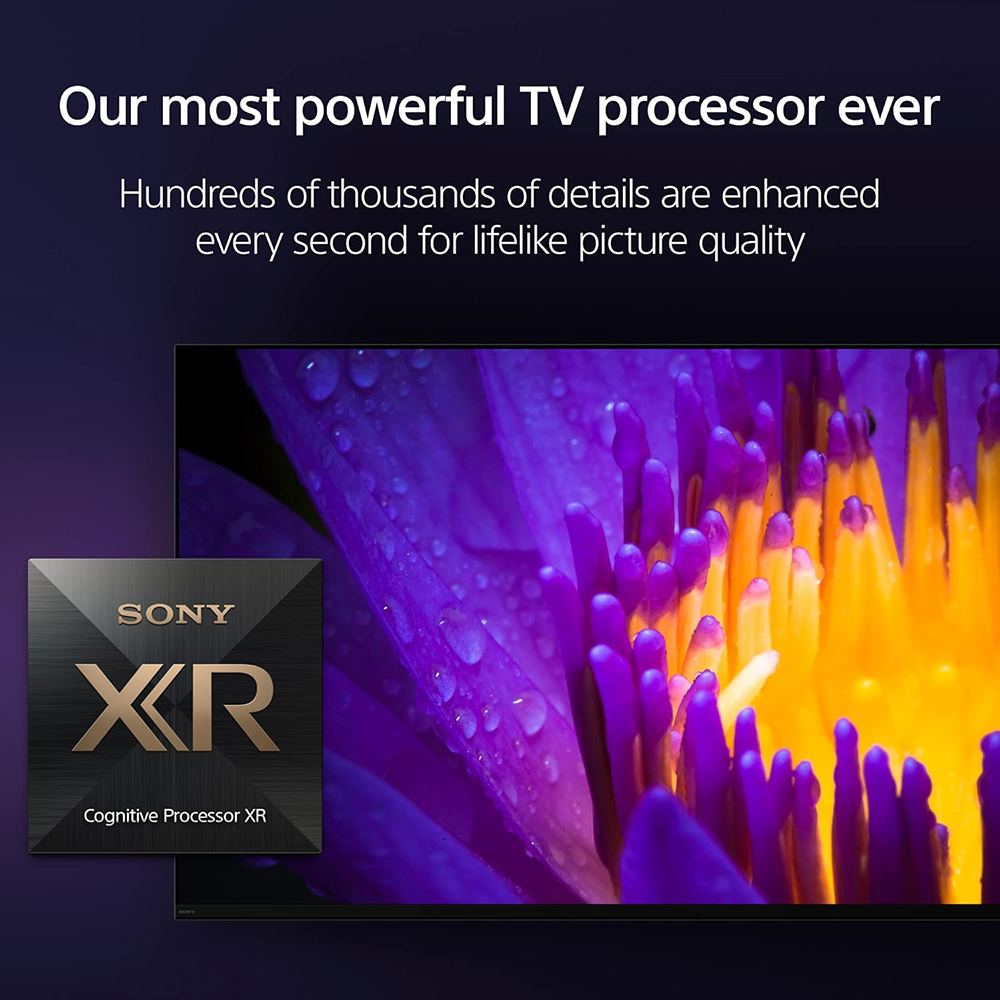
Audio Processing
We will talk more about the A75L’s audio capabilities in our dedicated audio section. But the TV comes with all the standard audio features you expect to find in a Sony premium model.
As such we find the XR Sound suite which includes Sony’s Acoustic Surface Audio system. Along with it we get XR Surround for virtually created audio and Voice Zoom 2 which is a dialog enhancement feature.
Lighting technology used
The A75L features the same panel technology as the A80L. So in theory these two should perform the same. As such, the TV comes with a WOLED panel without the addition of a heatsink like we saw in some more advanced OLED releases.
OLED Technology
The benefits of OLED technology are well known and it results in higher light control and precision. It also has the ability to turn off completely its pixels meaning that you can get totally black levels which is as good as it gets in any TV. And this really elevates the image quality tenfold compared to what we see in most LED LCD panels.
Because there is no backlight the A75L has no problems like blooming that creates bright halos around bright objects when seen in dark backgrounds. Also its image quality is not dependent on how many zones the backlight has as all FALD and mini LED LCD TVs do. So in this regard all OLED panels behave the same.
But as with everything, OLED has a few shortcomings. The first one is that all OLED TVs, due to the technology involved, cannot be as bright as LCD TVs can and this is the reason why QD-OLED and MLA OLED were invented. In the early years there were small advancements in this but the last few yearly OLED releases seem to have reached their peak potential.
And the second shortcoming is that OLED technology is more prone to permanent burn-in. We have seen manufacturers adding special features to combat this. But nevertheless OLED has slightly increased risk of burn-in due to the use of organic materials and should be handled with care.
But the reality is that the last couple of years OLED TVs have become very burn-in proof with all the safeties that manufacturers have added into them.
Number of Dimming Zones
As the TV can turn on and off each individual pixel you can claim that an OLED TV comes with million of dimming zones. Around 8.3 million to be more precise. This is why OLED TVs are so good with blacks that have no blooming visible.
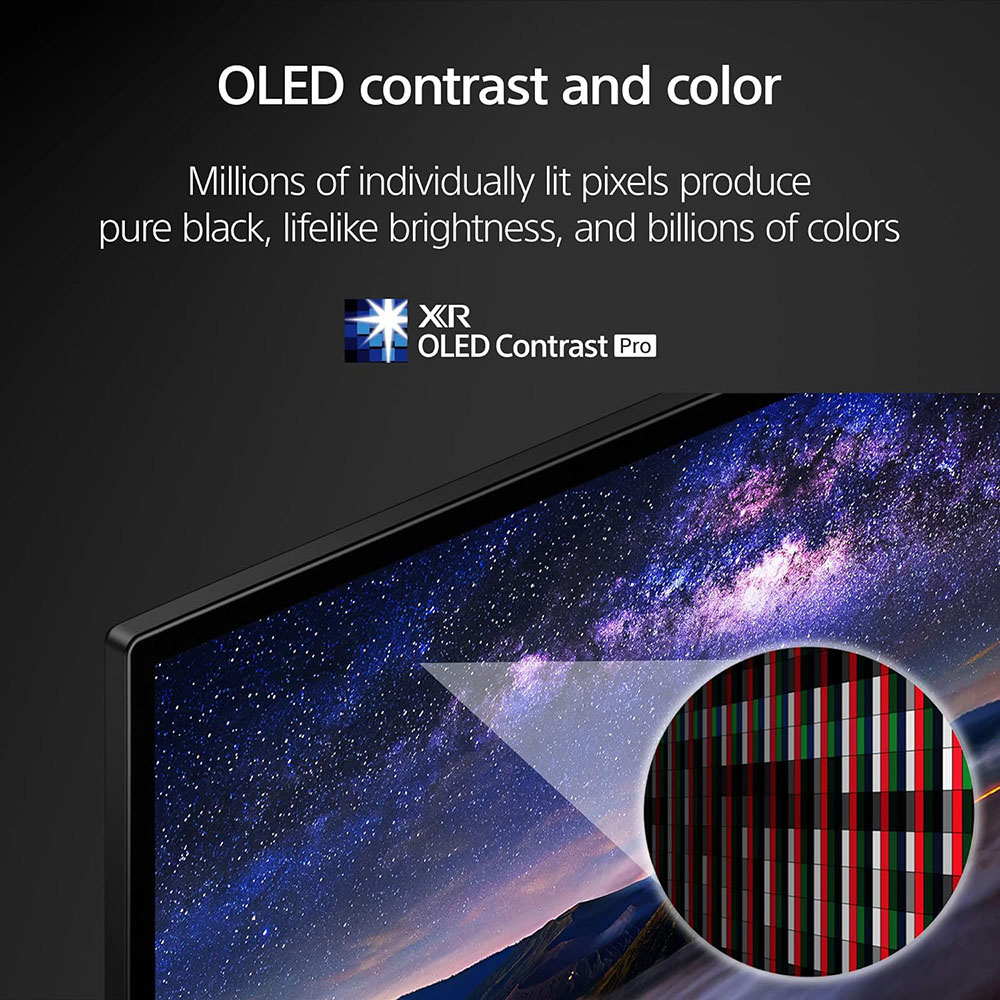
Blooming
In our blooming test patterns the A75L did perfect as you should expect from an OLED TV. Showing a bright object in a completely dark background without any blooming on sight is as good as it gets.
And this shows why OLED TVs remain some of the best TVs, even after so many years in the market. If blooming is your number one problem, OLED is one of the options you have to consider. And the A75L is the perfect low cost choice to go for..
SDR and HDR Brightness
Next we will be looking at the brightness of the TV. In terms of settings we used the same ones as we do in most Sony models. For picture mode we selected Custom with maximum brightness and Peak Luminance.
First test is the SDR brightness over a 10% window and the number we got was 397 nits which is a respectable number. With SDR the A75L may not be the brightest TV we have seen but considering its price, its more than enough.
We then switched to HDR content and in our HDR brightness over a 10% window test we measured 658 nits. For a traditional OLED panel this number is very good. Obviously with QD-OLED and MLA OLED this may seem low. But as always, the saving grace of OLED is the deep blacks. This makes, even the relatively low brightness output look much better.
The A75L performed exactly the same as the A80L here. No differences at all.
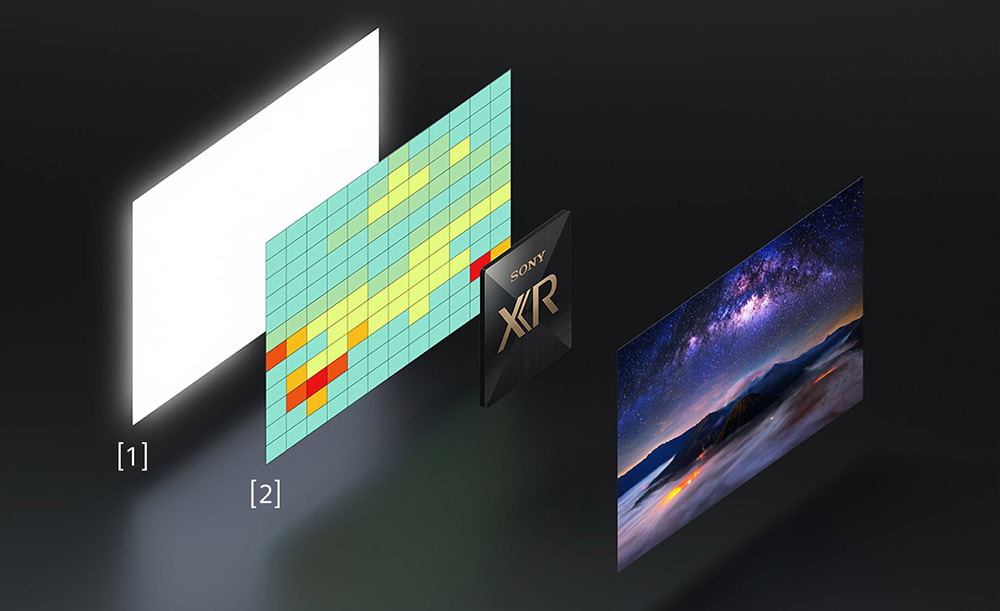
Automatic Brightness Limiter (ABL)
As with all OLED TVs, the A75L comes with an Automatic Brightness Limiter (ABL). This lowers the overall brightness of the screen when large parts of it become very bright for a long period of time. This may not be very obvious when watching a movie for example. But is more obvious with bright static images, or if you use the TV as a computer monitor.
The ABL on the A75L is a little aggressive but not to a point of becoming too obvious. The image would dim significantly compared to it before the ABL kicks in. But as we mentioned above this will happen only if you leave a bright static image for some time. With real world content you are not going to pay much attention to it most of the time.
Brightness Accuracy
Brightness levels were extremely accurate to the EOTF reference values up to its relatively sharp roll-off point which means that some details may get lost.
As usual, for the A75L to follow the curve accurately you have to use its Gradation Preferred tone mapping. Using the Brightness Preferred option will make images too bright. While turning it off will make the content look much dimmer than it should.
Contrast Performance
As for contrast using an OLED panel means that the A75L can switch off it’s pixels entirely. This means it gains almost infinite contrast ratio resulting in true deep blacks compared to greyish blacks we see in many LCD models.
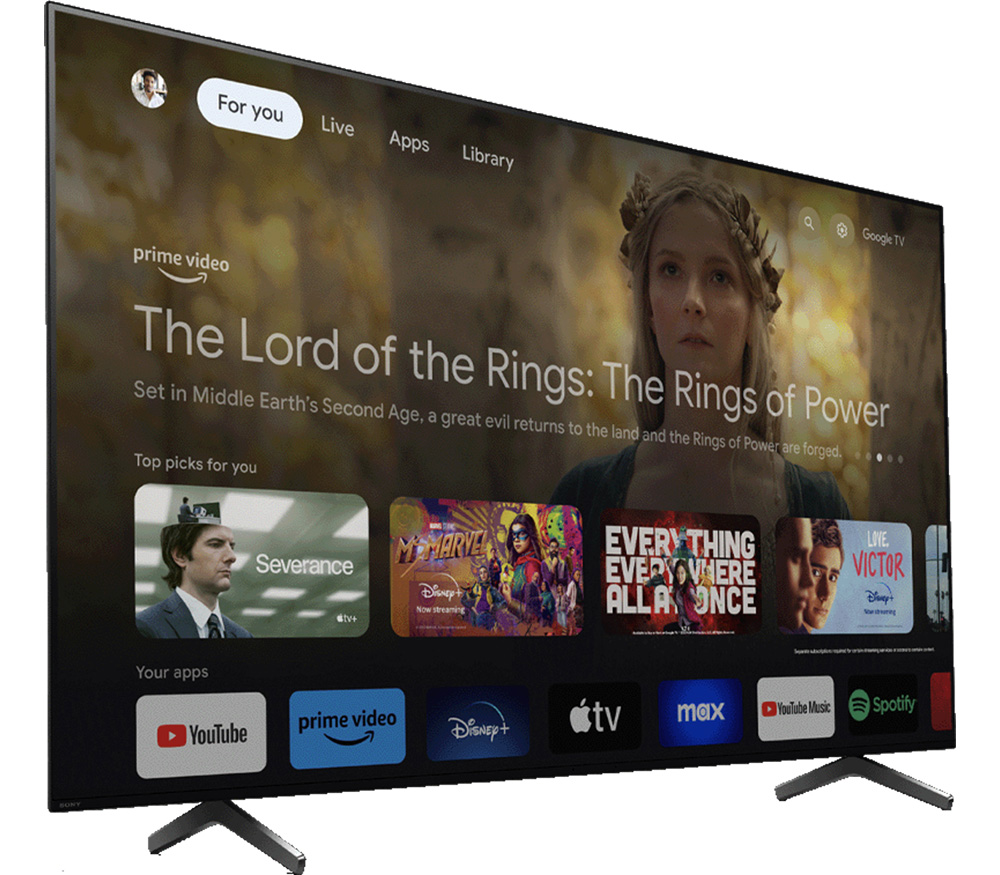
Viewing angles
Another advantage of OLED technology is the extremely good viewing angles this can achieve. This is another area where LED LCD TVs fail to achieve the same results. These have to rely on extra layers in order to somewhat improve this. But can never reach the numbers we see with OLED panels.
The Sony A75L is capable of retaining its brightness, color accuracy and black levels at very respectable levels up to 45 degrees of angle with a maximum of 50 degrees before the image starts to degrade a lot. But you most probably are not going to look at the TV at such extreme angles anyway.
With OLED’s amazing viewing angles it makes this TV an excellent choice not only for home theater rooms but also for any family setup, with all family members sitting in different positions in the living room.
HDR support
HDR support has remained the same the last few years. As such the A75L features the standard trio of HDR formats. These are the basic HDR10 which is required for 4K UHD playback, HLG that is used in broadcasting and lastly the more advanced Dolby Vision that uses dynamic metadata and offers the best quality from the three available.
The only omission is HDR10+. But if you don’t care about it then you shouldn’t really worry. Dolby Vision has far more support, although HDR10+ seems to be getting some traction both from online streaming services like Amazon Prime and in the UHD format.
If you really want to have both HDR10+ and Dolby Vision then you will have to look at some other brands like Hisense, TCL or depending where you live at Panasonic or even Philips. Unfortunately none of the big three (LG, Samsung and Sony) support all three of them.
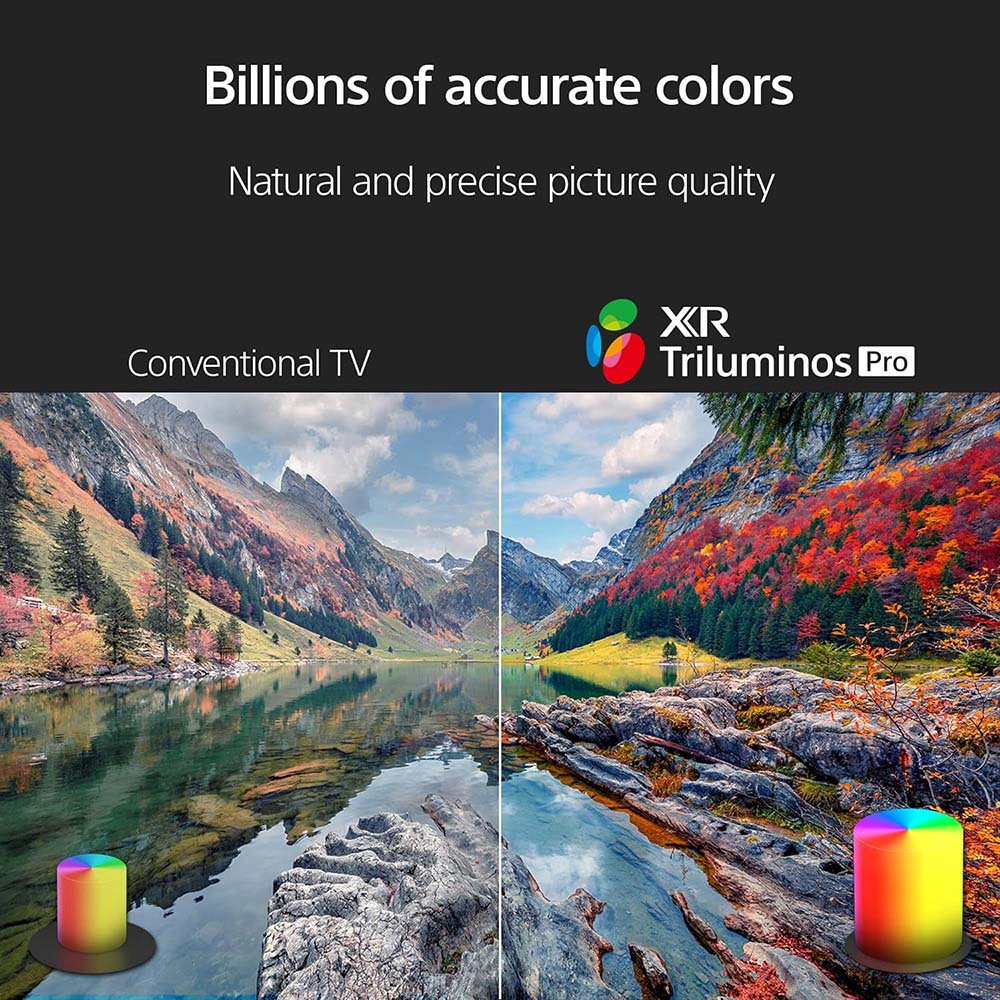
Color Coverage
The A75L, similar to most premium Sony TVs, is equipped with certain tech in order to allow it to display deeper and more lifelike colors. As such Sony has used an XR Triluminos Pro display in combination with their XR Picture suite.
From our measurements the TV can reach about 99% coverage of the DCI-P3 color space which is almost perfect. On the wider REC.2020 color space we got a coverage of 74% which again is great.
Not much difference compared to the A80L. Both TVs have almost the same color coverage.
Color Accuracy
Before calibration the TV had good color accuracy but not great. Most colors managed to stay under the DeltaE limit of three with only a couple of exceptions. Gamma was close to its target value. But white balance and color temperature did need some adjusting as their values were far from the desired ones.
After calibration the TV was even better than before. We managed to further improve gamma while white balance and color temperature were almost perfect. Also all colors were now way under the limit of three.
Obviously after calibration the TV performed far better. But even its out-of-the-box settings were not bad at all. This surely will satisfy you either you are a casual user that doesn’t like to spend much time calibrating or if you like to get the most out of your TV.
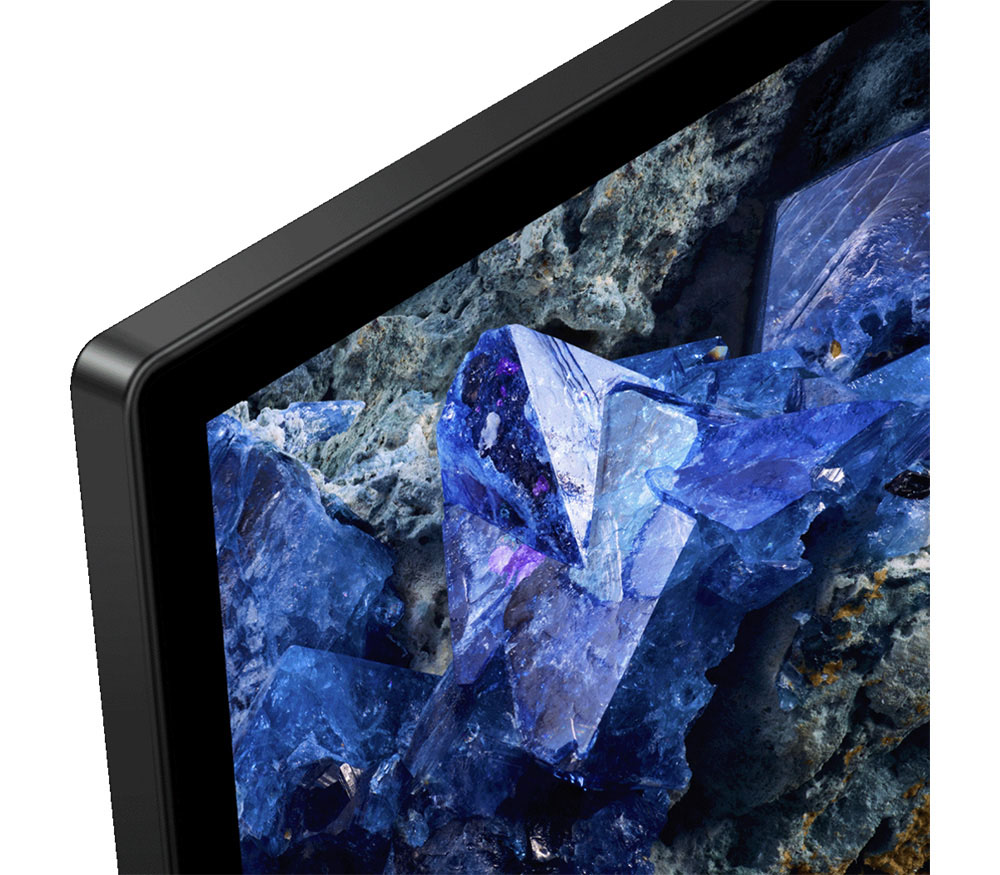
Color Gradients
Color gradients were extremely good. We only noticed some minor banding in the darker grey shades. But even this was very subtle and not bothering at all. This was the exact same behavior we saw in the A80L, showing how close these two TVs perform.
There is also a Smooth Gradation feature in case banding is bothering you. But you are going to lose some fine detail if enabled as is always the case with this feature.
Panel Uniformity
Grey and black panel uniformity were almost perfect. We did notice some very subtle vertical lines but these were extremely subtle and you are not going to notice them during normal use.
This is not out of the ordinary as all WOLED TVs show these. But from normal viewing distance you are not going to see them.
We didn’t notice any other abnormalities in the test unit we had.
Motion Performance
Next we have our motion performance tests.
The A75L uses a 120Hz panel along with Sony’s XR OLED Motion technology. This is the company’s motion interpolation feature we find in the XR Picture feature set of the Cognitive Processor XR.
The A75L, being a OLED, doesn’t need a backlight to light its pixels. While in theory this makes the TV flicker free in reality this is not the case but the flicker is so small that is not visible to the naked eye at all.
In terms of motion the TV did good with very little blur in fast action scenes. This is obviously a result of the A75L’s fast response times which is a well known OLED characteristic. On the other hand a lot of stutter shows up with low framerate content that you can fix only by enabling motion interpolation.
The TV can also remove judder either from 24p or 60p content, which is great for any kind of content.
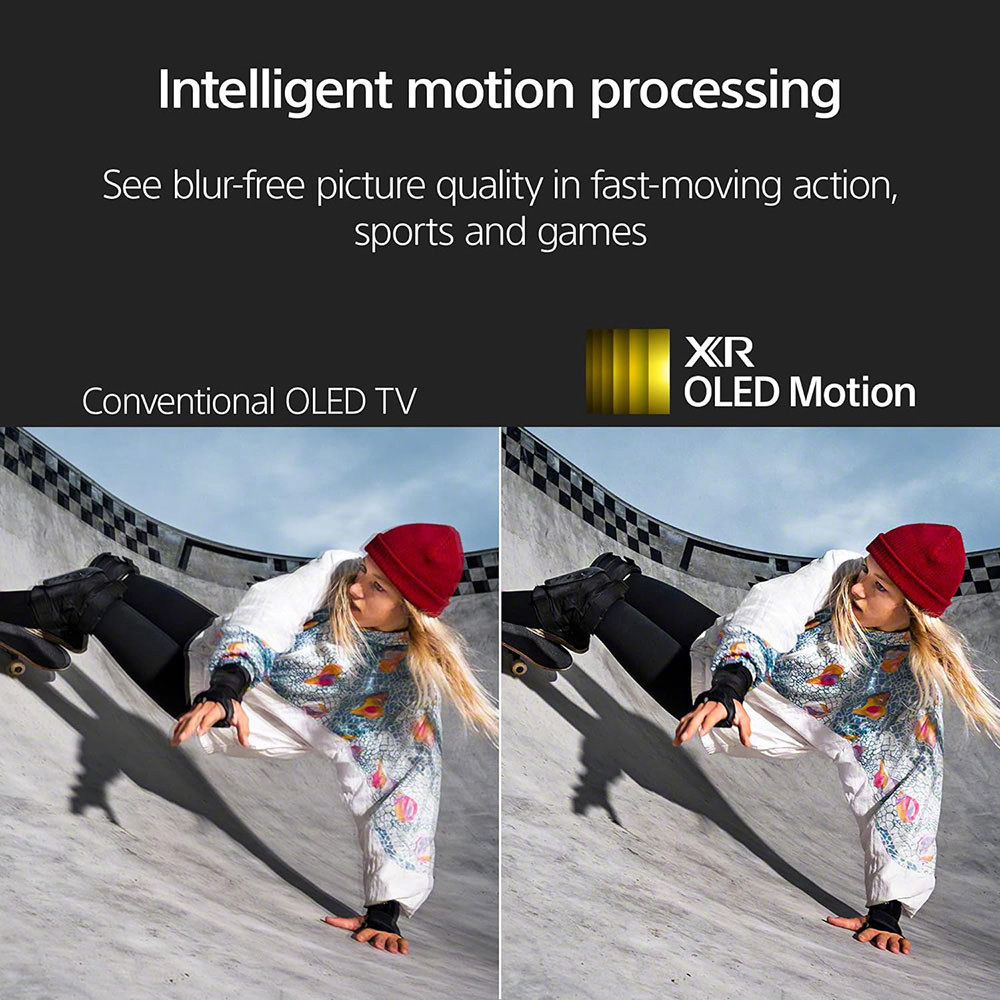
Motion Interpolation
As we mentioned above, the TV comes with the usual motion interpolation feature. This can smooth motion and remove blur and judder from fast camera movements. Motion interpolation in the A75L was as good as in many other premium and top tier TVs.
Obviously in very demanding scenes we did see some artifacts. But we did expect this. And these were mostly due to the very fast camera movements, which is a problem with almost all TVs.
One thing we noticed here is that in scenes with a lot of action, some times the TV would stop interpolating completely. This would create an inconsistency in the frame rate which was a bit frustrating at times.
Also using very aggressive settings will make the “Soap Opera Effect” to appear so you have to adjust the settings accordingly. Motion Interpolation can be enabled by turning CineMotion to High and MotionFlow to Custom. From there you can adjust the Smoothness slider accordingly.
Black Frame Insertion (BFI)
Black Frame Insertion (BFI) is also available and can be enabled with the Clearness setting in the MotionFlow menu. With BFI the A75L was able to smooth motion considerably but not without some undesirable side effects.
The most obvious one is that brightness takes a visible hit. Which is detrimental with an OLED that cannot achieve extremely high brightness output. Also the BFI feature can work only with 60Hz. It doesn’t work with 120Hz and cannot work with VRR either.
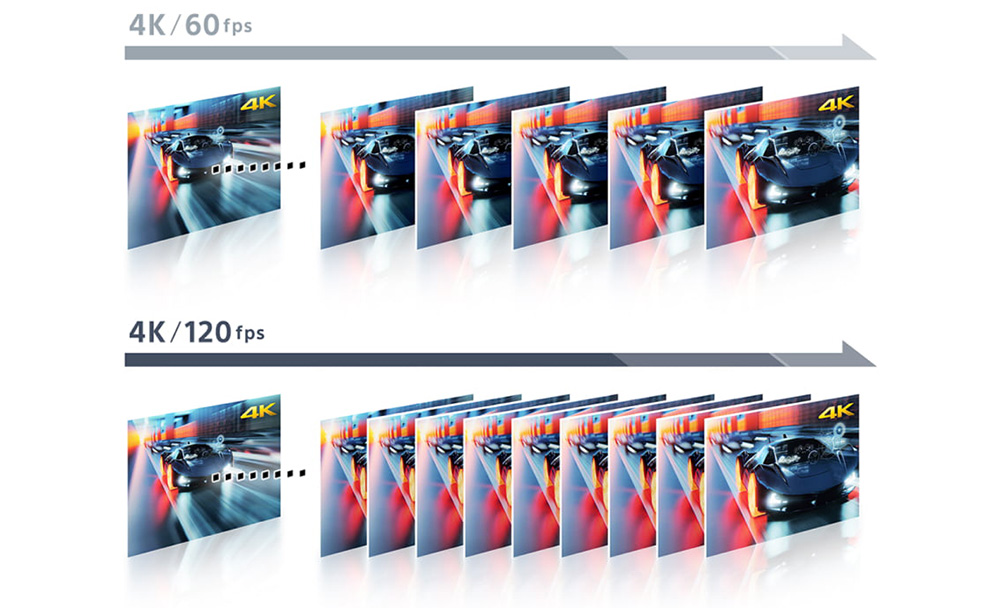
Overall Motion Impressions
The A75L behaved as good as any traditional OLED TV we checked before, including the A80L.
It has some noticeable flaws because of the technology it uses. Motion interpolation will fix some of those issues but make sure to find the right settings that will not make motion look unnatural.
Input lag Measurements
Next we will test the TV’s input lag performance.
We measured the A75L to have an average of 17.0ms input lag in both 1080p and 4K resolutions at 60Hz. Standard performance here. At 120Hz we measured 9.0ms in both 1080p and 4K resolutions which again is very good, even if not the best we have seen.
Sony TVs always had slightly higher input lag than both Samsung and LG, something we have seen in all their releases. So these numbers come to no surprise to us.
But the difference is relatively small, and gaming can really be a pleasure. Just make sure you use the available Game mode. As outside that the input lag will greatly increase to around 145ms which is a bit high even for slow paced, offline gaming.
Unfortunately, as with all Sony TVs, the A75L does not support either 1440p resolution or 144Hz refresh rate. So 4K@120Hz is the best you can get. Keep that in mind as we start to see certain brands supporting either 1440p or 144Hz, or even both. But with the A75L, being a low cost OLED offering, we were not expecting otherwise.
Also there is no 4K@120Hz with Dolby Vision support that we saw recently in the Sony A95L. For this the new Pentonic 1000 is required which Sony included only in their top QD-OLED offering.
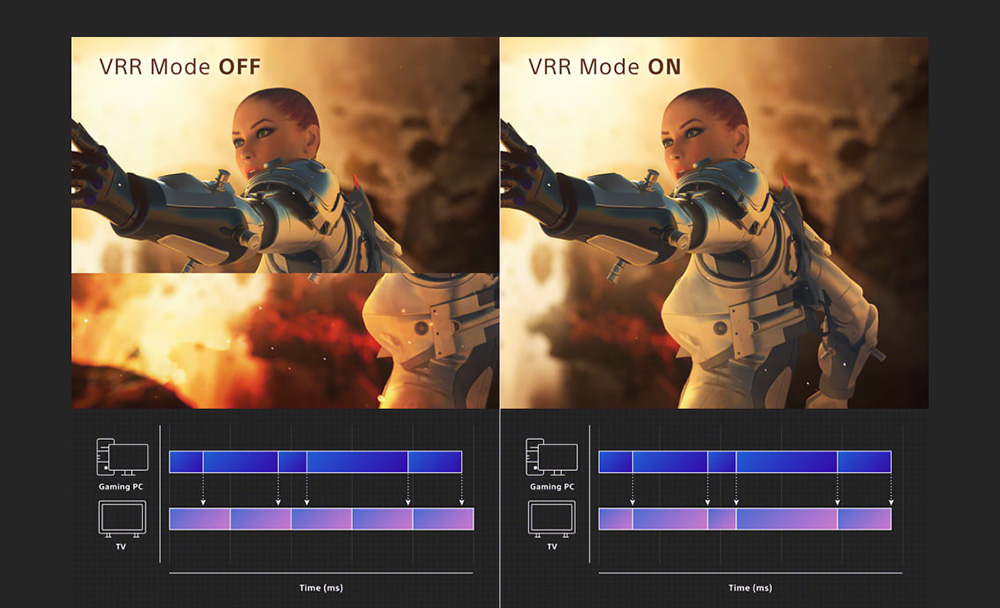
Other Gaming Features
We should also not forget to mention that the TV supports Auto Low Latency Mode (ALLM). This can be used with any devices that support that like the PS5 and Xbox consoles and can greatly benefit users.
Unfortunately, as with all Sony TVs there is no HGiG mode. But we do get Auto Genre Picture Mode and Auto HDR Tone Mapping which are Playstation 5 specific features.
VRR Support
The A75L comes with VRR support out of the box, which Sony made standard last year. HDMI Forum VRR and G-Sync are supported but unfortunately not FreeSync. Sony is not supporting that in any of their releases so far.
Trying Out a Few Games
As we usually do, to get a feel of the TV’s responsiveness we connected both our PS5 and Xbox series X to one of the HDMI 2.1 ports of the A75L. The games of choice lately are F1 2022, which supports both 60Hz and 120Hz, and Dead Space, which is a 60Hz game only.
During our time with both games the A75L behaved exactly the same as the more expensive A80L. The TV showcased good reaction times and in both games our commands would register on screen blazingly fast.
If you want a low cost OLED solution for gaming the A75L definitely fits the bill. Surely it is missing a few gaming features but the basics are all there.
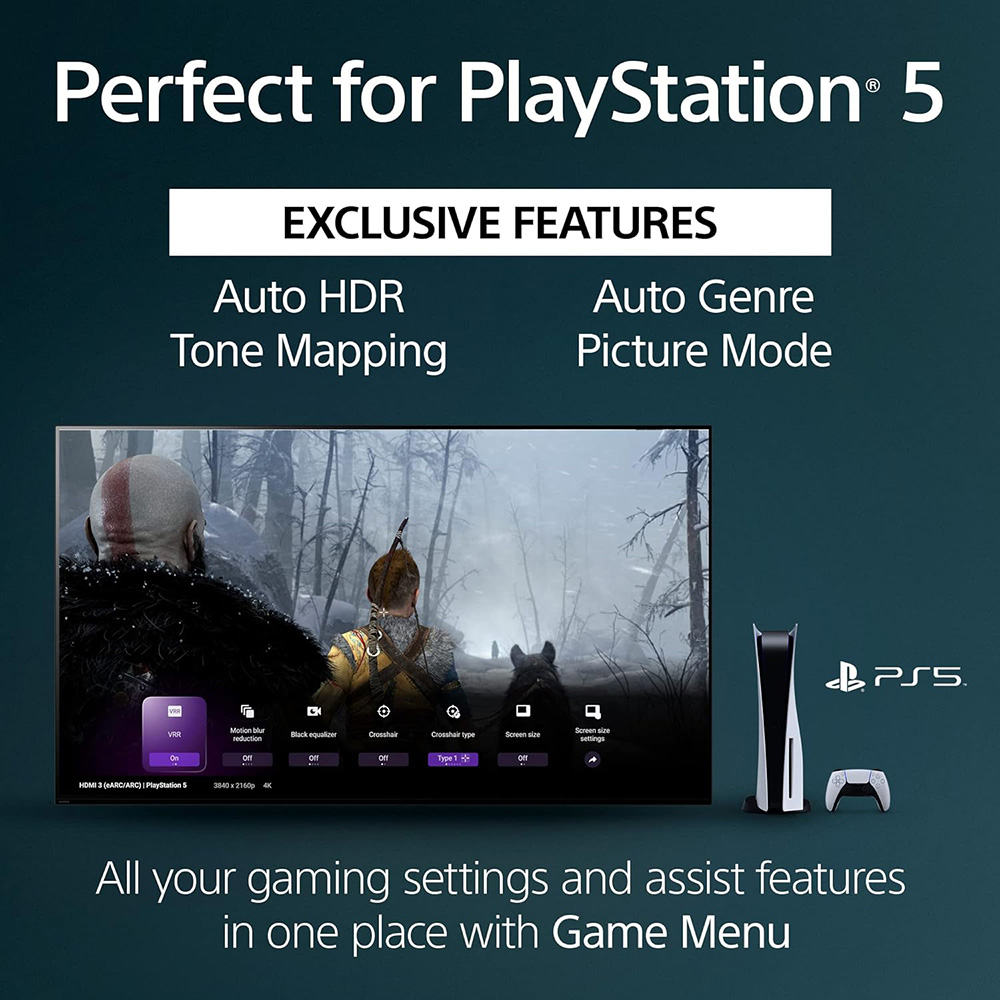
Overall Image Quality Impressions
With the A75L’s specifications being so close to the nearly $300 more expensive A80L we were curious how close this two would perform.
It seems that the A75L is indeed a stripped down A80L. As in terms of image quality there is no difference whatsoever between these two. They have the same brightness, same colors, same accuracy, same motion performance and same gaming features.
So if this the only thing that matters to you then you can do yourself a favor, get the A75L and save a few bucks.
Audio Quality
When it comes to audio, Sony has developed several technologies that uses in their TVs and the one that is included in the A75L is called Acoustic Surface Audio. Basically, this is a less capable version of the Acoustic Surface Audio+ system used in the A80L. And it seems that this is the 2nd major difference we find between the A75L and the A80L.
This system basically uses actuators at the back of the panel that vibrate and use the whole panel as a huge membrane and thus create sound. This way it seems like audio is coming from within the screen giving you a better sense of realism.
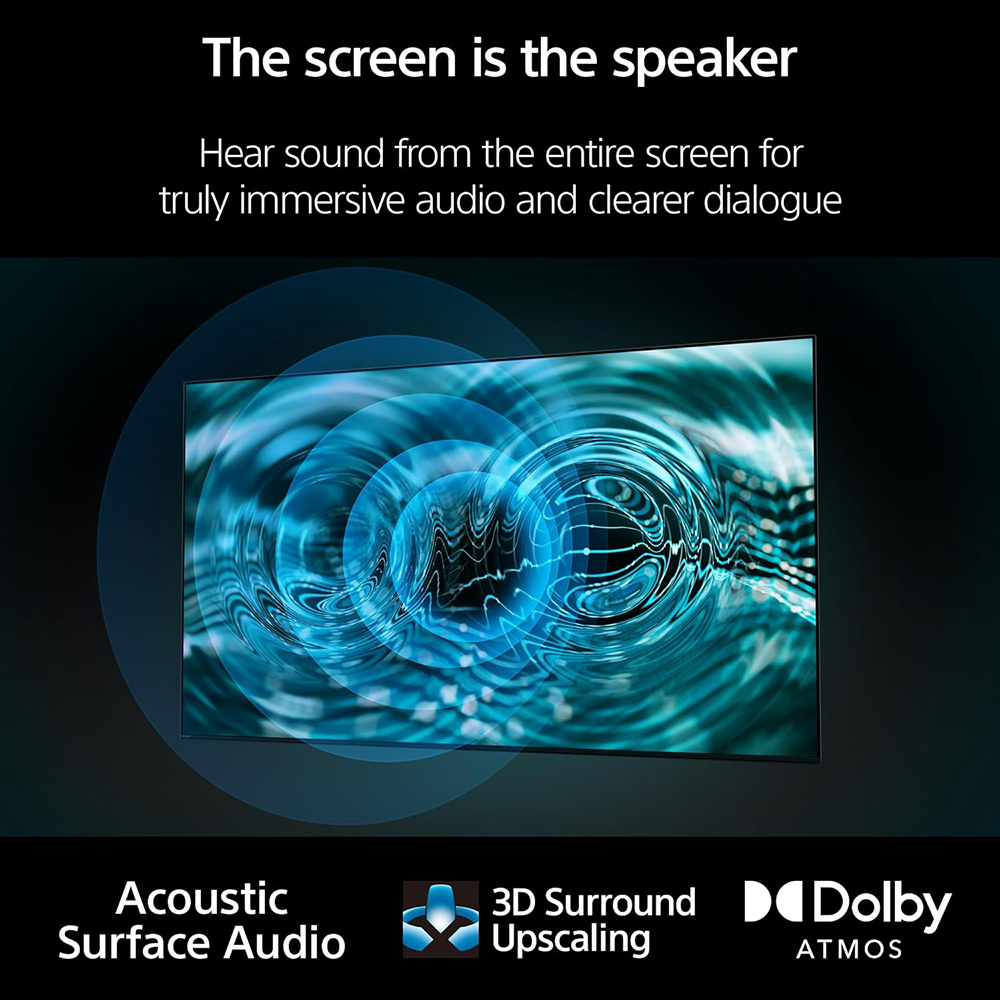
Audio System – Channels & Power Rating
The TV uses a 2.0 channels configuration with 40 watts of power output. Power distribution is 10 W + 10 W + 10 W + 10 W.
There are two actuators in this TV along with two full range (Bass Reflex) woofers.
Audio Formats Support
There is support for Dolby Audio, Dolby Atmos and DTS Digital surround sound. But naturally the TV fails to create a really immersive surround experience. As it lacks the necessary hardware, like height and rear speakers, the final sound output is far from what a real surround system can output.
Also keep in mind that Sony supports DTS and can even pass-through both Dolby Atmos and DTS:X signals from its eARC port. So if this important to you then the Sony is one of your definite choices.
Since last year Sony was the only of the big three (Samsung, LG, Sony) to still support DTS. But LG brought it back in 2023 in some of their top tier models, upping the competition considerably. Samsung is the only brand that does not support DTS at all right now.
Audio Features
There are plenty of audio features that Sony likes to include in their units and the A75L seems to get the standard feature set.
First we have XR Surround. With it the A75L is using 3D surround upscaling in order to create a more immersive virtual surround environment. This is done by using two of Sony’s proprietary virtual technologies. The first one is called S-Force Front Surround which is responsible for creating virtual surround sound. The second one is Vertical Surround Engine which is responsible for over the head audio like Atmos effects.
Also present is Voice Zoom 2 which is Sony’s dialog enhancement technology. This feature detects voices and after analyzing them uses special filtering to suppress ambient sounds. This way even subtle dialog is greatly enhanced.
A couple more features is Sony’s Acoustic Center Sync and 360 Spatial Sound Personalizer. With the first you can combine the TV with a Sony soundbar for a more synchronized output. The second can be used in combination with other speakers, like the SRS-NS7 wearable speaker, for spatial sound.
The A75L naturally features Sony’s Acoustic Auto calibration in order to get the best audio performance no matter your sitting position. This can be used in combination with the optional Bravia Cam as it will detect where you sit in the room and calibrate the audio accordingly.
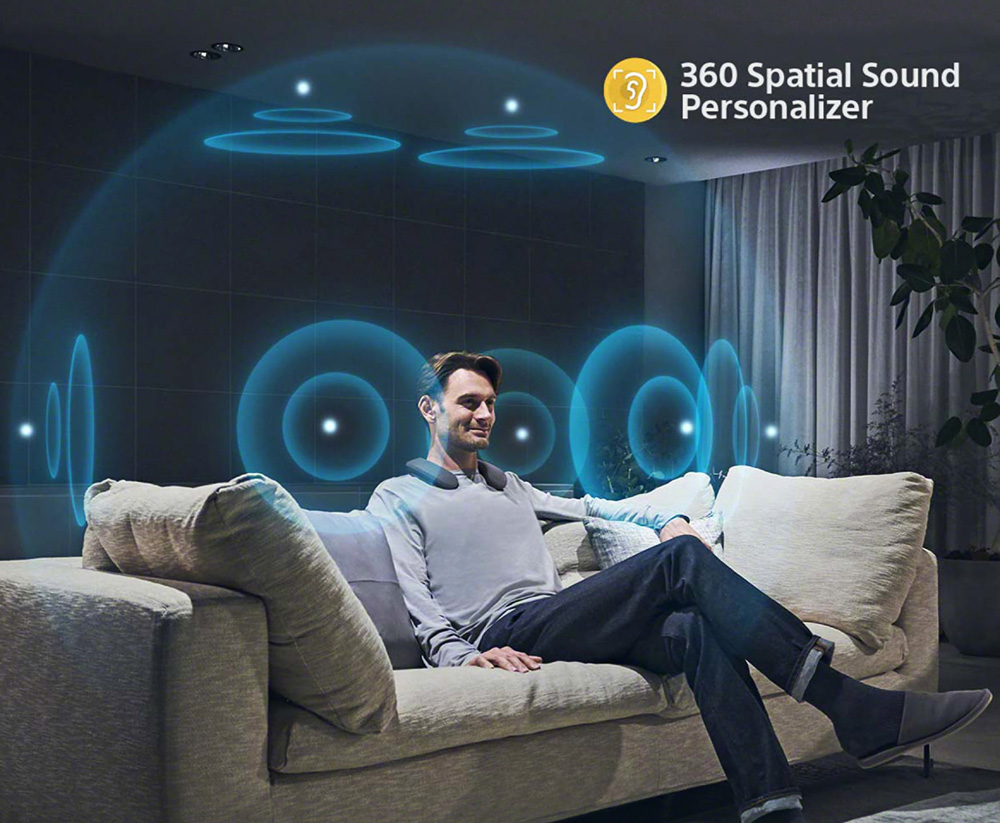
Overall Audio Performance Impressions
Not much to say here. The A75L’s sound output is what you should expect from a standard audio system like this. For casual use the TV’s output will suffice. It can get loud and dialog is clear and distinct enough, no matter your sitting position. For broadcasting material, sports and occasional TV series viewing you don’t need anything else.
But if you want sound to match the TV’s spectacular visuals then you will need at least a good Dolby Atmos soundbar, if not a good surround system. If you are more into movies then this is an expense you definitely have to include with the TV itself.
Ports and Connectivity
Next we will be looking at all the connection ports available. And here is another area where the A75L is entirely the same as the A80L.
Going from top to bottom we get two USB ports for connecting external storage or powering various devices. We also get a digital optical audio output for connecting older equipment that do not support HDMI connections.
Beneath we find a composite video input that also acts as an S-Center speaker input and four HDMI ports for connecting all your devices. We also get an Ethernet port for wired connection to your network, an RS-232C port for control, an IR input and the usual antenna/cable connector.
HDMI Specifications
As with all Sony TVs, we get two HDMI 2.1 ports along with two more older HDMI 2.0 ones. Although some other manufacturers like LG and Samsung offer four HDMI 2.1 ports at least two are better than one.
The problem here is that one of them is also the one with ARC/eARC functionality. So if you plan on using that then you are left with a single HDMI 2.1 port. In general all TVs that feature only two ports use Mediatek’s SoC. But at least the HDMI 2.1 ports in the A75L provide full bandwidth in order to allow high frame rate gaming and all HDMI 2.1 gaming features.
The HDMI 2.1 ports in the A75L support ARC, eARC, HFR, ALLM and VRR. With VRR both HDMI Forum VRR and G-Sync are available out of the box, something that applies to all 2023 Sony models. FreeSync VRR on the other hand is not in any of Sony releases.
Also keep in mind that the A75L does not support Dolby Vision at 120Hz. Only the new Sony A95L supports that because it uses the new MediaTek Pentonic 1000 SoC.
Connectivity Observations
Again, the Ethernet port is still the usual 100Mbps one. But this does not surprise us, as we have yet to see a TV making the transition to Gbit adapters.
Streaming requirements and internet connections have greatly advanced the last few years. This made the 100Mbps limit obsolete a while back. And while most TVs update their WiFi capabilities (some models, including the A95L, even support WiFi6 this year) the Ethernet adapters are still the same.
And considering that the A75L comes with Bravia Core, Sony should be at the forefront of this much desired change. We say this because Bravia Core’s highest quality Pure Stream available at 80Mbps require a minimum internet speed of 115Mbps. So in essence you cannot do that with a wired connection and have to rely on wireless with all the problems this can bring.
And lastly Sony, unlike some of the other big manufacturers, actually provide a USB 3.0 port in most of their TVs. Usually manufacturers don’t seem very fond of using the newer USB ports. And rely mostly on the archaic 2.0 version even for many of their top premium models. So having one is definitely a plus.
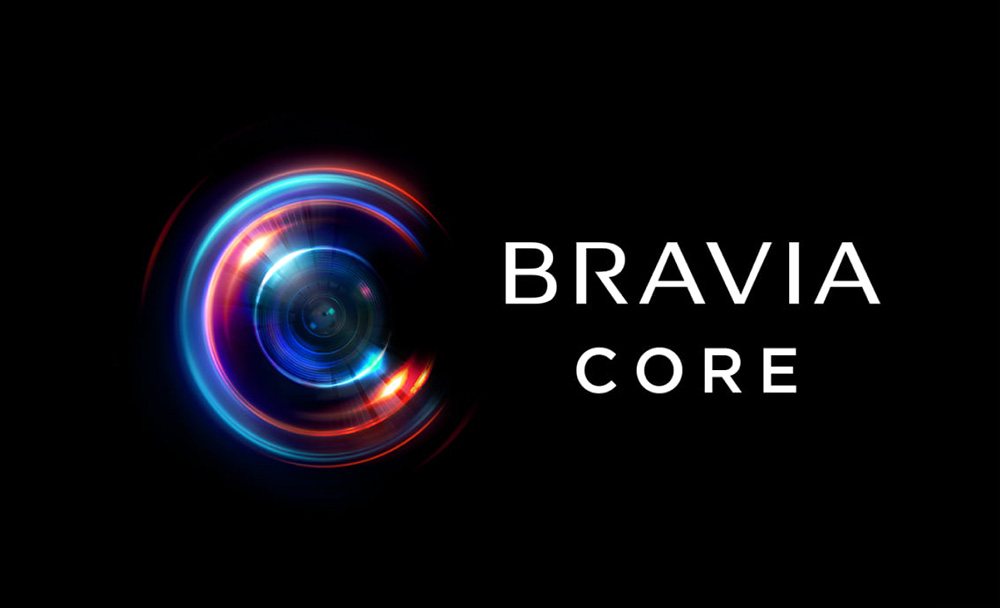
Wireless Capabilities
As for its wireless capabilities the Samsung A75L supports WiFi5 (802.11ac) along with Bluetooth v4.2.
OS, Apps and Features
Strangely the A75L comes with an older version of Google TV, namely version 10.0.
But to be honest the last few versions of Google TV do not have major differences between them and they keep their overall layout unchanged.
Google TV 10.0
Google has done a poor job at making clear of the differences between Google TV and Android TV that is still being used from some TV brands.
To make things real simple Google TV is still Android TV but with an extra layer on top of it. Think of it like how it works with Android smartphones. Most manufacturers that use Android in their releases they use on top of that their own layer that gives this extra something to their UI that make them unique both in appearance and functionality.
The same is with Google TV. You still basically use Android TV but there is the extra Google TV layer on top in order to make the UI feel different both in looks and functionality.
Google TV seems to have been designed around recommendations, either it be movies, TV shows or applications and this seems to be the main focus of all the latest OS in general. During setup the wizard asks you what specific streaming services you use in order to customize the Home screen recommendations.
Keep in mind that Google TV is still Android at its core even though it looks different from Android TV. But with Google TV things seem more fluent, more direct and more easy to navigate around.
As far as navigation and overall user experience the A75L was as good as the rest of the top tier Sony TVs we tested lately. We didn’t experience any noticeable slow-downs and all apps would open and close really fast. Scrolling was very smooth, either it was the Android options or the Google TV settings.
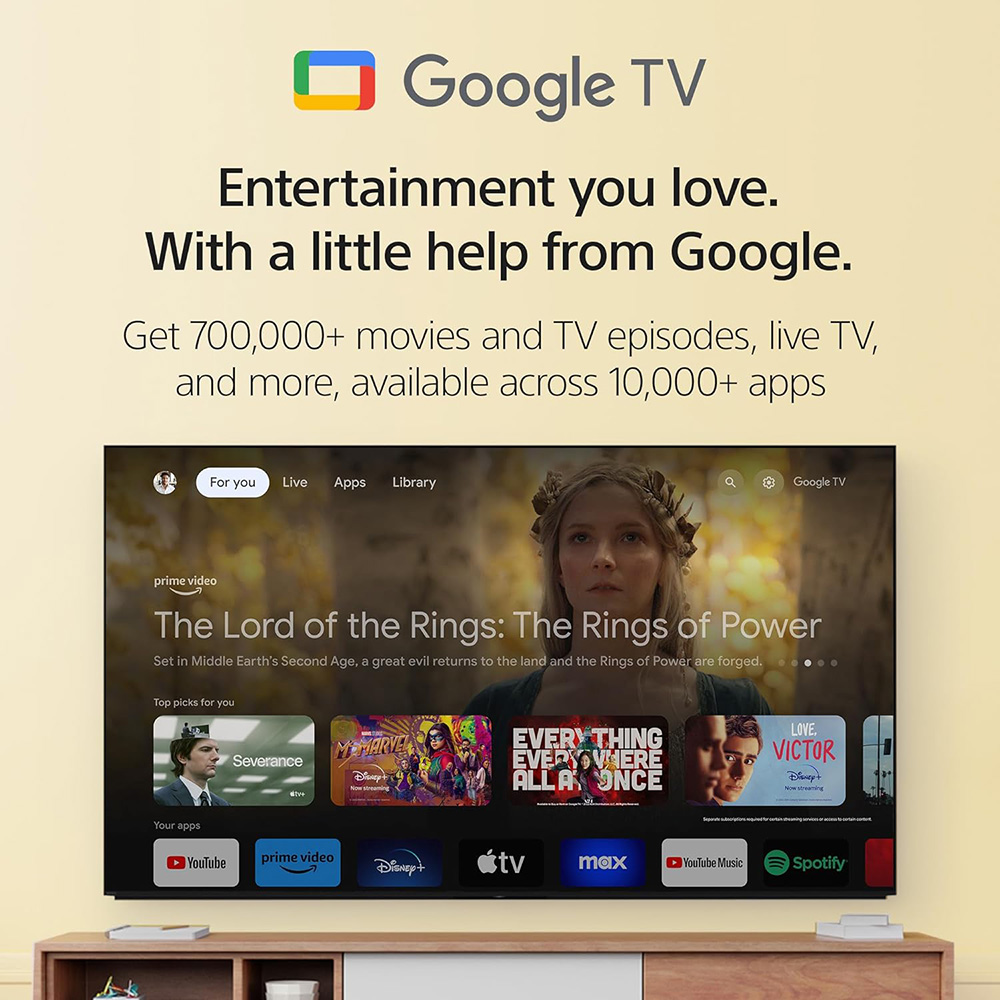
Streaming Capabilities
If there is one thing that Google TV has in abundance that is huge app support. Through the included Google Play Store you can find literally thousands of apps that you can download and use. Except from the pre-installed ones of course. There is so much content available that you will hardly miss anything.
All the big names are obviously present like Google TV, Disney+, Netflix, Amazon Video, Hulu, HBO Max, Apple TV and Youtube. There is also Pandora, Tidal, Google Play Music, Spotify and iHeartRadio to name a few.
As always some of them are region dependent so make sure the ones you are interested in are working in your area. Lastly many apps like Netflix and Youtube support playback for both 4K and HDR content for those interested in it. But since each app is different we cannot say which apps support what resolutions and HDR formats in various regions.
Various Connectivity Features
Chromecast is also available and it gives you the ability to stream content from other Chromecast enabled devices like mobile phones and tablets directly to the TV.
You also get support for both Apple Airplay 2 and HomeKit, which is now named Apple Home. With Airplay 2 you can stream content from other Apple devices on your TV while Apple Home lets you control certain aspects of the TV through your mobile device.
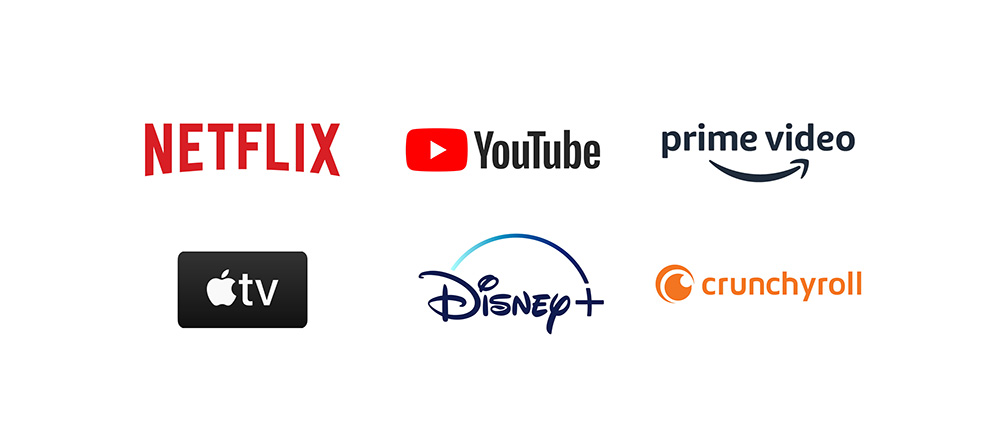
Voice Control
Voice control is also present, as usual. The TV can work with both Google Assistant and Amazon Alexa. You also have the ability to use Apple’s Siri through Apple Home in case you prefer Apple’s solution.
And here is another difference the A75L has compared to the A80L, even if a minor one. With the A75L you can use voice control only through the remote. As there is no built-in microphone on the TV itself as was the case with the A80L. So you cannot have a completely hands-free experience with this.
Built-in Media Player
As with most TVs nowadays the A75L can playback a wide range of files and codecs through its USB port. We tested the TV by trying a selection of files we keep for this reason. The files we tried were various combinations of video and audio codecs and the results were very good considering this is a built-in media player.
The most usual video files would playback without any problems. A few exceptions included files that use unusual codec combinations or extremely high bitrates which you are not going to find in the majority of video files. So in most cases the TV will do fine.
As we always mention, these built-in media players are not going to replace your dedicated media player but for certain use they will do the job.
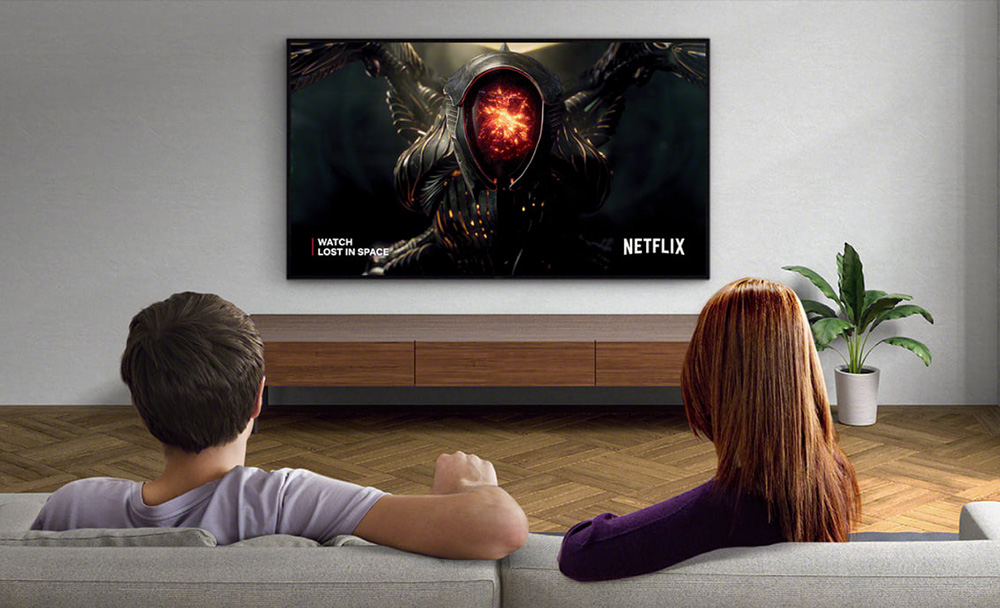
Netflix Adaptive Calibrated Mode
The A75L also comes with the Netflix Adaptive Calibrated Mode which we also saw in some other top tier Sony TVs. What this does is to allow you to experience picture quality close to a filmmaker’s vision and intent for all content that is streamed through the Netflix streaming service.
This feature works together with the ambient light optimization feature of the A75L by optimizing the picture brightness based on your room lighting conditions.
Calman Ready
For one more year many Sony TVs, including the A75L, are Calman Ready. To address color variations from the production process, the TV is ready to use Portrait Displays’ high-performance Calman auto-calibration software.
This allows an unprecedented level of calibration and the ability to fine-tune adjustments simply not possible through conventional picture settings. It delivers high-fidelity color reproduction that’s true to the original TV signal, and can even adapt to the subtlest changes in color that may occur over time.
Bravia Cam
Bravia Cam is another returning feature. This is an optional accessory that can be purchased separately and can further enhance the functionality of this TV.
With the Bravia Cam the A75L can detect where you sit in the room and adjust the picture and audio accordingly. Other functions include gesture control and power saving features among others.
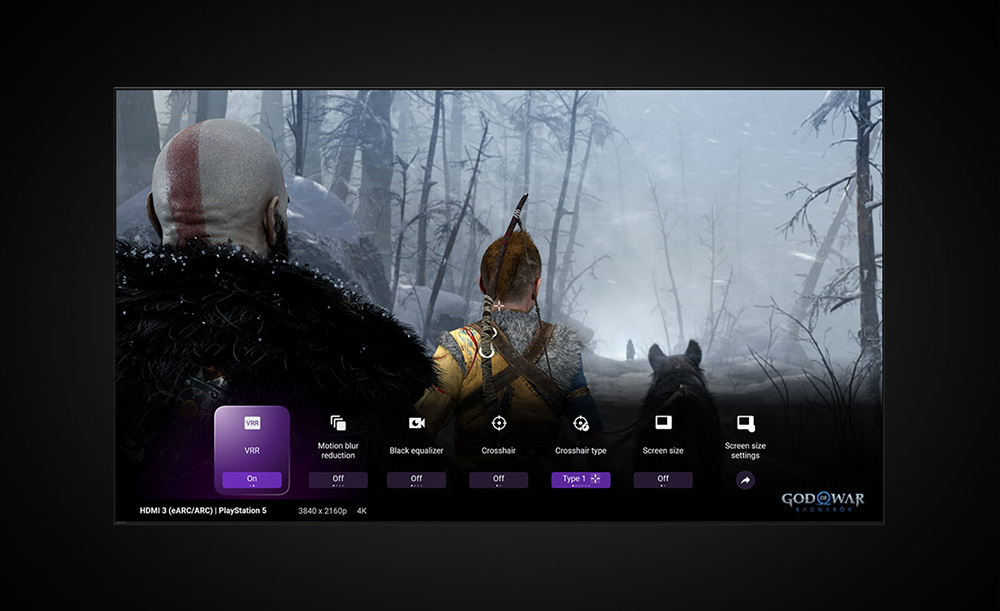
Game Menu and Eco Dashboard
It took some time to implement something similar to what the other competing brands have but finally Sony made it, even if they are the last ones to do it.
The new Game Menu offers you the ability to gain access to certain gaming features like VRR, screen size settings and picture features. And all of this with a press of a button.
The Game menu feels less refined than LG’s and Samsung’s implementations but keep in mind that this is Sony’s first year for rolling out this feature. As happened with the other brands, now that it’s out they will surely update and refine it in future releases.
Also new this year is the Eco Dashboard. This allows you to change energy settings but also indicate you how these settings affect power consumption. Everything through a single, comprehensive screen.
Compared to other TVs
The first obvious model for comparison would be the 2022 Sony A75K. Unfortunately we didn’t have the chance to test that out last year so we cannot say how these do compare. But specs wise they do look identical.
The most interesting comparison is definitely with the 2023 Sony A80L. The A75L is about $300 less expensive and for this lower cost you do not lose much. As the TV gets a slightly less capable audio system, a plastic stand design, and doesn’t have the built-in microphone used for voice control. In terms of image quality and performance they are almost identical and for this reason we definitely suggest the A75L over the A80L.
The most obvious comparison we left for last and this is the 2023 LG B3 OLED. Both feature the same OLED technology and are priced exactly the same. In a way the LG is the only real competitor in this price. The Sony has better image processing and slightly higher HDR brightness. On the other hand the LG supports FreeSync. This is almost a tie but we will give a slight edge to the Sony here.

Final Thoughts
OLED TVs are considered some of the best in terms of image quality for many years now. But their prices were far beyond what most people could afford. But the Sony A75L proved that you don’t have to spend a fortune to enjoy impressive visuals.
The most affordable OLED TV Sony has for 2023 is every bit as good as most other traditional OLED releases including the new A80L. Image quality is excellent, its black levels are perfect, you get plenty of gaming features and its smart capabilities are undeniable. And all these at almost $300 less than the Sony A80L.
As for its downsides, these are more or less what you expect from a traditional OLED TV. Its peak brightness, although good enough, cannot reach the extreme heights of QD-OLED and MLA OLED. As a Sony TV you will only have 2 HDMI 2.1 ports. It’s missing some gaming features like FreeSync, 1440p and 144Hz support. And lastly its stand does not support multiple positions like in some other Sony models.
We reached the end of our Sony A75L review and what you need to keep in mind is that when you buy an OLED TV image quality is the single most important aspect of it. And here the Sony A75L shines. You get all the benefits of traditional OLEDs but at a reduced price. What more you can ask for? So if you really want an OLED TV but afraid of the cost, the Sony A75L is definitely your best option.
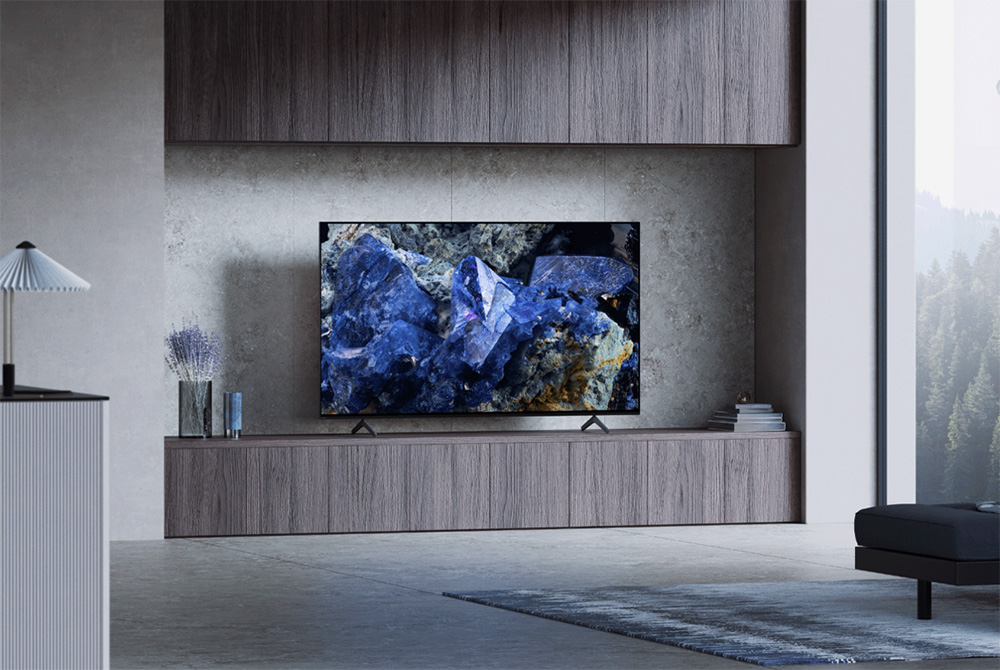
For more reviews you can check our dedicated 4K OLED TV reviews section or even look at our Product Reviews Table where you can find the brand and specific product you are looking for.
Cheapest Places to Buy :
*We are a reader-supported website. When you buy through links on our site, we may earn a small affiliate commission at no extra cost to you. Home Media Entertainment does not accept money for reviews.*


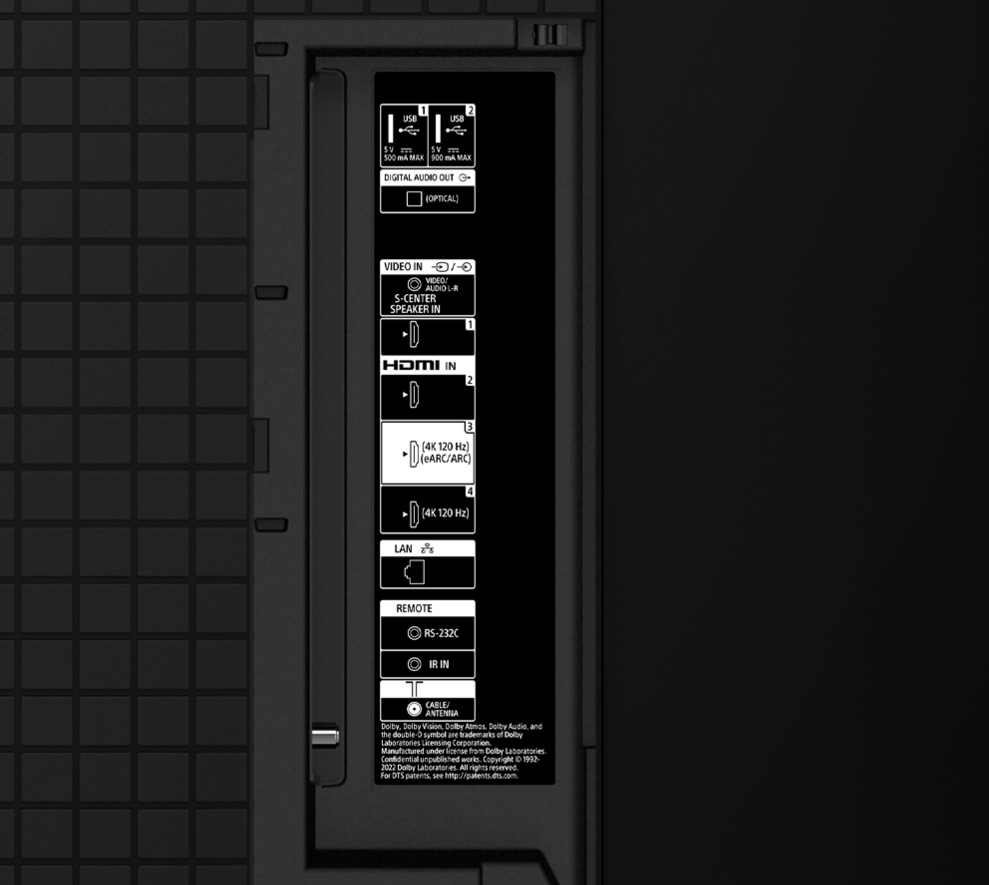
The Sony A75L is impressive! It’s great to see OLED quality at a more affordable price. The Acoustic Surface Audio system sounds interesting, but is it a significant difference from the A80L’s premium audio? Looking for a new TV and trying to figure out if the A75L is the right one. Any ideas when you will post your LG B3 OLED review? I will probably wait for that before deciding.
Hello Ryan. Audio is not so much different between the A75L and A80L. Small differences that do not make a big impact overall. As for our LG B3 review, this should come relatively soon.
Its interesting that Sony released the A75L so close in specs to the A80L. It will surely cannibalize some of the A80L’s sales. I don’t see many going for the A80L because the differences are really so small that is not worth it the extra cost. Personally I would lower its specs further in order to differentiate it much more from the A80L.
Hello Wesley. I see your point and it does have some reasoning behind it. I cannot see someone going for the A80L if these two are side by side. But I do not know why Sony decided to release it with so similar specs. Well, the sales will show if they did good or not.